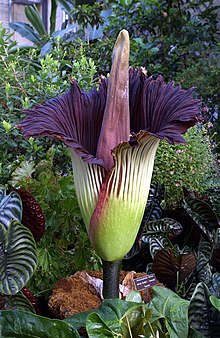| Amorphophallus | |
|---|---|

| |
| Titan arum (Amorphophallus titanum) is the Amorphophallus with the largest unbranched inflorescence | |
| Scientific classification | |
| Kingdom: | Plantae |
| Clade: | Tracheophytes |
| Clade: | Angiosperms |
| Clade: | Monocots |
| Order: | Alismatales |
| Family: | Araceae |
| Subfamily: | Aroideae |
| Tribe: | Thomsonieae |
| Genus: | Amorphophallus Blume ex Decne. |
| Type species | |
| Amorphophallus campanulatus Decne.[1] | |
| Species | |
|
See text | |
| Synonyms[2] | |
| |
Amorphophallus (from Ancient Greek amorphos, "without form, misshapen" + phallos, "penis", referring to the shape of the prominent spadix) is a large genus of some 200 tropical and subtropical tuberous herbaceous plants from the Arum family (Araceae), native to Asia, Africa, Australia and various oceanic islands.[3][4] A few species are edible as "famine foods" after careful preparation to remove irritating chemicals.[5] The genus includes the Titan arum (A. titanum) of Indonesia, which has the largest inflorescence of any plant in the genus, and is also known as the 'corpse flower' for the pungent odour it produces during its flowering period, which can take up to seven years of growth before it occurs.[6]
- ^ Amorphophallus Blume ex Decne. | International Plant Names Index. (n.d.). Retrieved November 15, 2023, from https://www.ipni.org/n/331135-2
- ^ "Amorphophallus Blume ex Decne". Plants of the World Online. Royal Botanic Gardens, Kew. 2022. Retrieved 6 December 2022.
- ^ Kew World Checklist of Selected Plant Families
- ^ Sedayu, A., C. M. Eurlings, Gravendeel, B., & Hetterscheid, W. (2010). Morphological character evolution of Amorphophallus (Araceae) based on a combined phylogenetic analysis of trnL, rbcL and LEAFY second intron sequences. Botanical Studies, 51, 473–490.
- ^ "Robert L. Freedman, The famine foods database". Archived from the original on 2009-12-21. Retrieved 2009-11-06.
- ^ "Titan arum". Eden Project. 2018-02-04. Retrieved 2020-12-30.